Energy Markets Update
Weekly natural gas inventories
The U.S. Energy Information Administration reported last week that natural gas in storage increased by 54 Bcf. The five-year average injection for September is about 78 Bcf. Total U.S. natural gas in storage stood at 2,694 Bcf last week, 7.6% less than last year and 11.5% lower than the five-year average.
US power & gas update
- Excessive heat in the West has pushed CAL-ISO demand to new records at 52,061 MW on Tuesday. Temps reached 116 degrees in the State’s capital Sacramento earlier this week, highest in 100 years.
- Temperatures are expected to revert to normal in California over the next few days, but remain above average along the East Coast and central MidWest.
- Gas production has been slowly building in recent months, with levels currently at a 9 month high. However, high temperatures and strong gas burn within the generation sectors is keeping gas in storage around the 5-year minimum.
- After a month-long rally from $8/MMbtu to almost $10/MMbtu last week, NYMEX gas for Q4 2022 tumbled 10% in Tuesday’s trading and is now about $8/MMbtu. This could be a good entry point for those waiting on the sidelines.
- The EPA ruled on Tuesday that Cheniere Energy Inc, a major LNG exporter, had been denied its emission exemption request for two of its turbines in the Gulf Coast. Many feel this may cause at least parts of the facility to shut down for installation of new turbines to meet the emission standards. This is bearish for US prices and bullish for European prices.
- On Sep. 2 Russia’s Gazprom indefinitely suspended gas deliveries to Germany via the Nord Stream pipeline, citing “an oil leak”, but more likely a tactical response to European nations replenishing inventories at record levels, which is attributed largely to US LNG redirects. European lawmakers are considering a myriad of reforms to energy markets and price indices.
New England grid operator, utilities call for energy reserve
- Earlier this week, ISO New England and several regional utilities drafted a memo to state and federal regulators calling for an energy reserve as “regional insurance” to cover rare events such as extreme weather.
- The call-to-action also emphasizes the need for the liquefied natural gas import facility in Everett, MA to remain operational past its anticipated shutdown date in June of 2024.
- ISO New England asserted that the facility is critical to maintaining reliability of the regional electric grid and that it provides flexible gas supply that will support the clean energy transition.
- Growth in renewable energy was expected to make the plant obsolete by 2024, but ultimately, growth has been slower than expected.
 Source: Northeast Gas Association
Source: Northeast Gas Association - The LNG infrastructure in Everett is still necessary to backstop reliability for the regional power grid in the winter. Its 3.4 bcf storage capacity keeps the lights on during cold winter days, however there is no proper mechanism to incentivize its commercial existence under current market design. Therefore,
- ISO New England suggests a study be conducted to allocate costs, presumably to the electric power rate base.
- Further complicating the future of the site, the Mystic Station has long been a highly sought-after piece of real estate for an entertainment or hospitality development after its retirement.
- City officials have aimed to create a loophole to surpass the fact that the land is a designated port area, a title that severely limits real estate development. They have offered billions of dollars in tax breaks to developers and have even considered use of eminent domain to seize the land from Constellation, the current owners, to develop the area.
Maine high court says referendum blocking CMP corridor could be unconstitutional
- Last week, Maine’s highest court ruled that the November 2021 voter referendum that blocked Central Maine Power (CMP) from constructing a high-voltage transmission line, was unconstitutional.
- The New England Clean Energy Connect (NECEC) transmission line is a $1 billion project aiming to deliver up to 1,200 MW of clean energy from Quebec to New England. The project has been shelved since last fall due to an approved voter referendum to block the development.
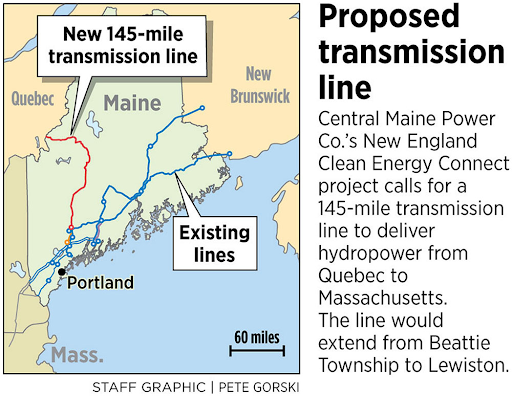
Source: The Portland Press Herald
- The court ruled that the referendum infringed upon the constitutional rights of the developers by aiming to change requirements of a previously approved permit from the Maine Public Utilities Commission.
- It is important to note that this decision does not change the referendum decision last fall - it simply sends the case back to the Business and Consumer Court of Maine, where opponents of the project plan to continue their case against NECEC.
- At the time the “no” referendum was approved by voters last fall, the project had already cleared 124 miles along the line’s path and spent approximately $450 million.
- Members of NECEC have called the decision a win for renewable energy for New England and the country as a whole.
- Opponents plan to argue that the project will permanently harm the ecology of Western Maine while making an insignificant impact on greenhouse gas emissions.
- As we have previously reported, some of the opposition parties were actually major energy generators in the region (i.e., Nextera and Calpine) gaslighting as the environmental lobby in order to preserve their market power.
- We see this move by the Maine court as a positive sign, particularly with the backdrop of high prices and tight supplies this winter. Our view is that decisions concerning critical infrastructure and clear benefit to consumers should not be delegated to the electorate, or to special interest groups by proxy.
Possibility of rolling outages across California
-
Extreme temperatures across California and the West Coast have put unprecedented pressure on the CAISO grid this week.
-
The grid reached a peak demand of 52,061 MW on Tuesday afternoon, surpassing the previous record set in 2006.
-
The system operator has been sequencing through its emergency procedures every day this week, restricting maintenance, calling on the public for conservation, and activating emergency generation and demand response.
-
On Tuesday, CAISO activated its EEA3 alert, which allows it to call upon utilities to begin rolling outages across their service territories, however the system narrowly avoided this action.
-
Intentional blackouts took place for two days in August of 2020 in CAISO territory. These blackouts were the first in 20 years. CAISO has a couple challenging days ahead before temperatures are expected to moderate.
-
Power prices have surged this past week, reaching price caps of $1000 and $2000 for the Day-Ahead and Real-Time markets, however this has been concentrated in the evening hours when loads remain strong and solar generation declines.
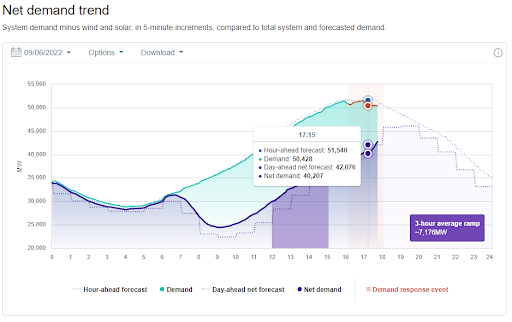 Source: CAISO
Source: CAISO
California passes climate-friendly bills, extending Diablo Canyon
-
California legislators have codified climate related goals to achieve 90% clean energy by 2035 and carbon neutrality by 2045.
-
The bills aim to facilitate expansion of the clean energy industry in tandem with the newly-passed Inflation Reduction Act at the federal level.
-
Recent extreme weather events resulting in high power prices have strengthened the focus on grid reliability not only in California, but across the United States and even in Europe where the Germans are reversing ill-conceived policies to prematurely shut down some of their own nuclear reactors.
-
Statewide, California has been adding more gas power capacity than any other source in order to avoid blackouts, but this week has demonstrated that balancing renewable supply and gas peakers has its limits. Baseload generation is an important part of the equation.
-
Legislation to extend the life of the Diablo Canyon nuclear plant was passed with strong support from the Governor, extending the retirement of the plant by five years from the planned date in 2025.
-
A Stanford University and MIT study predicts that if left operational through 2035, the Diablo Canyon plant would reduce carbon emissions from power generation in California by over 10% of 2017 levels. Reliance on natural gas would lower as grid reliability would increase. If operated to 2045 and beyond, Diablo Canyon could save up to $21 Billion in power system costs and spare 90,000 acres of land from use for energy production.
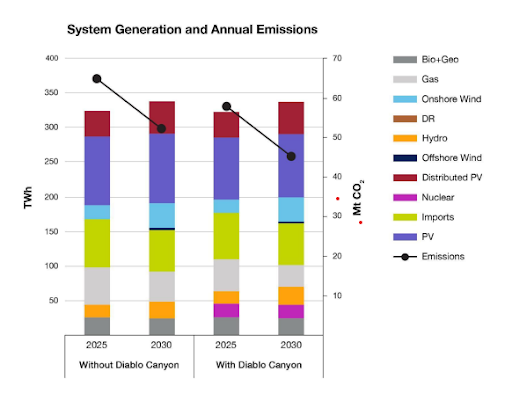
Source: Stanford University and MIT - The 2,200 MW plant has been cited as key to ensuring grid reliability in California, with legislators arguing that current clean energy generation is not powerful enough to cover generation from Diablo Canyon.
- Currently, Diablo Canyon provides about 17% of California's zero-carbon energy and is responsible for just under 9% of the state’s total electricity supply.
Natural Gas Storage Data
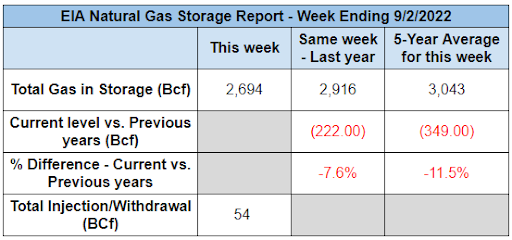
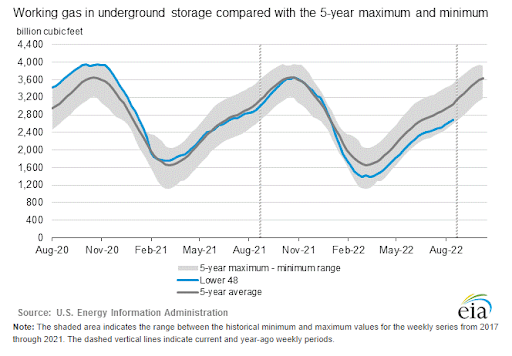
Market Data
Use the filters to sort by region
Market data disclaimer: Data provided in the "Market Data" section is for the newsletter recipient only, and should not be shared with outside parties.



